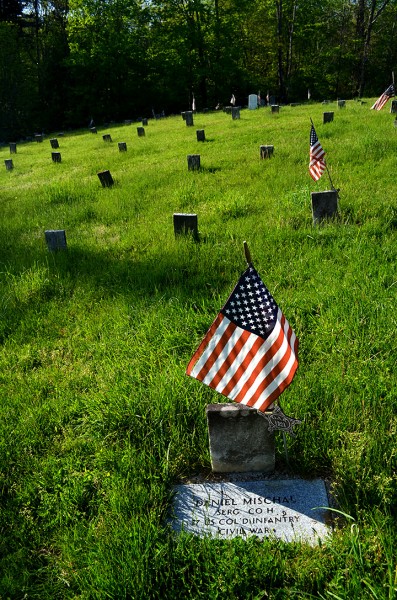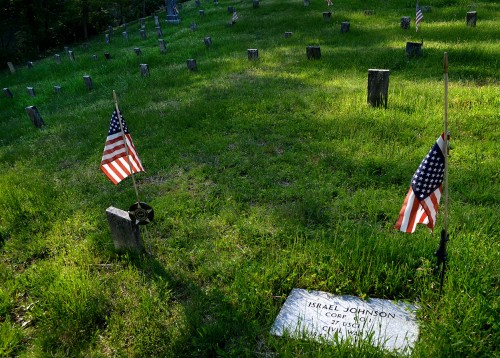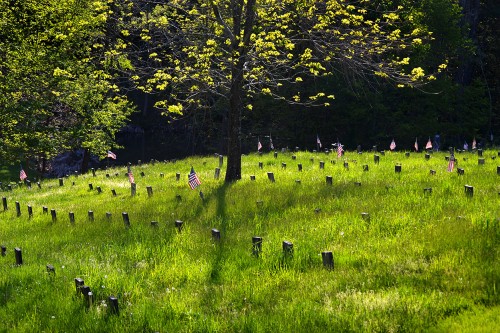 Eighty veterans are buried in the three cemeteries that served The Ridges, formerly known as the Athens Lunatic Asylum. Curator Jessica and I were fortunate enough to quickly find the graves of two men who served in the United States Colored Infantry in the Civil War.
Eighty veterans are buried in the three cemeteries that served The Ridges, formerly known as the Athens Lunatic Asylum. Curator Jessica and I were fortunate enough to quickly find the graves of two men who served in the United States Colored Infantry in the Civil War.
Daniel Mischal was a sergeant in the 27th United States Colored Infantry, Ohio’s second African American regiment. The regiment was organized at Camp Delaware on January 16th, 1864, and served until the end of the Civil War; it was then mustered out September 21, 1865.
Battle of Crater
 Here is the grave of Corp. Israel Johnson.
Here is the grave of Corp. Israel Johnson.
The Colored Infantry not only fought the Confederates; they also had to contend with racism on the Union side. The Ohio Historical Society repeats Sgt. James H. Payne’s account of the August 12, 1864, Battle of the Crater:
“…(T)wo regiments [the 43rd USCI and 27th USCI] drove the enemy from their breastworks, and took possession of the blown up fort; but while they did, all the white soldiers lay in their pits and did nothing to support our men in the struggle; they lay as if there was nothing for them to do for one hour after the explosion took place…How easily Petersburg could have been taken on the 30th of July, had the white soldiers and their commanders done their duty! But prejudiced against colored troops prevented them…I can only conclude that our men fell unnecessarily in the battle on the 30th. In their retreat, they received the cross-fire of the enemy, and no small number were killed by our own artillery.”
Burials were austere
 A visitor’s guide to the cemeteries says “Virtually everything about burial on the Ridges was austere. The unembalmed bodies were washed, wrapped in simple shrouds, and placed in plain wooden coffins. Normally, the funeral “procession” was comprised of six people: four gravedigger/pallbearers, a representative of the hospital and a chaplain.
A visitor’s guide to the cemeteries says “Virtually everything about burial on the Ridges was austere. The unembalmed bodies were washed, wrapped in simple shrouds, and placed in plain wooden coffins. Normally, the funeral “procession” was comprised of six people: four gravedigger/pallbearers, a representative of the hospital and a chaplain.
“The service consisted of an opening and closing prayer and, in the case of Christians, a reading from Scripture – no personalized eulogy, no one else in attendance. From the 1870s to 1943, graves were marked only with small, sequentially numbered, marble stones which corroded rapidly and were easily broken – no names, no dates.”
Vets not recognized until 2005
 This particular cemetery served the Asylum from its opening in 1874 until about 1913, so the flags you see flying recognize servicemen who fought before World War I.
This particular cemetery served the Asylum from its opening in 1874 until about 1913, so the flags you see flying recognize servicemen who fought before World War I.
Two other cemeteries on the property received bodies until 1972, After that, unclaimed bodies were taken to two rural Athens County cemeteries.
In all, the National Alliance on Mental Illness (NAMI), which has taken on the task of identifying the graves of veterans, has found two who fought in the Mexican War, sixty-eight from the Civil War, a member of the Confederate Army, and another two veterans who served with the United States Colored infantry. Three veterans served in the Spanish–American War, and seven fought in World War I.
Starting in 2005, the Ridges Cemeteries Committee has been organizing Memorial Day Ceremonies for the many veterans buried at the asylum. NAMI started the Memorial Day Ceremonies to help restore dignity to the patients on the Ridges and to help recognize the sacrifice of the veterans, many who had probably suffered through post traumatic stress disorder as well as other post war symptoms.

That’s good to know about. Thank you, Ken.
Well, no sooner did I get back to my own Black Hawk project when I learned that the story I’m working on is connected to yours. It concerns the 23rd Regiment of United States Colored Infantry. A brother-in-law of a Black Hawk guy (as I call them) in the U.S. Army was William Baird, a lieutenant at the same Battle of the Crater at Petersburg, and was taken prisoner. His family story, as told in a one of the county histories of the late 19th century, doesn’t say what happened to the men under his command, but one online source says a lot of soldiers were killed in the act of surrendering. So it’s a reasonable guess that Baird’s being a white officer was a reason he wasn’t killed along with them. It would be interesting to learn more about that.
Baird’s father had come to North America to join a utopian socialist colony on the shore of Lake Huron, on the Canadian side. As usually happened, the colony failed, and then a daughter (sister to Lt Baird) married the guy who was the subject of my bike ride to Port Huron last weekend.
Well done Dr. Steinhoff and Curator Jessica! Especially after the posting of John Gorentz, I was most intrigued; so I followed up to learn more about the Battle of the Crater:
http://en.wikipedia.org/wiki/Battle_of_the_Crater
The story of the Battle of the Crater is most fascinating, and I recommend all history and Civil War buffs should read about it. The use, or rather misuse, of Gen. Edward Ferrero’s division of black soldiers was a travesty.
Here is a blurb to wet your interest:
The Battle of the Crater was a battle of the American Civil War, part of the Siege of Petersburg. It took place on July 30, 1864, between the Confederate Army of Northern Virginia, commanded by General Robert E. Lee and the Union Army of the Potomac, commanded by Major General Ambrose Burnside (under the direct supervision of the general-in-chief, Lt. Gen. Ulysses S. Grant).
After weeks of preparation, on July 30 the Federals exploded a mine in Maj. Gen. Ambrose E. Burnside’s IX Corps sector, blowing a gap in the Confederate defenses of Petersburg, Virginia. From this propitious beginning, everything deteriorated rapidly for the Union attackers. Unit after unit charged into and around the crater, where soldiers milled in confusion. Grant considered the assault “the saddest affair I have witnessed in the war.” The Confederates quickly recovered and launched several counterattacks led by Brig. Gen. William Mahone. The breach was sealed off, and the Federals were repulsed with severe casualties.
Brig. Gen. Edward Ferrero’s division of black soldiers was badly mauled. This may have been Grant’s best chance to end the Siege of Petersburg. Instead, the soldiers settled in for another eight months of trench warfare. Burnside was relieved of command for the last time for his role in the debacle, and he was never again returned to command.[1]